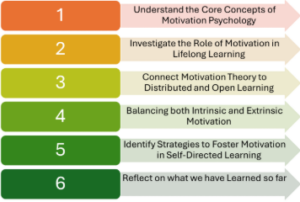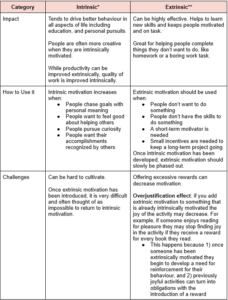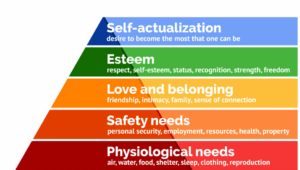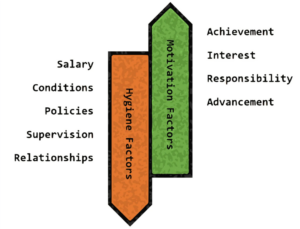Ready, Set Go!
Why do some people choose to learn new languages? Why do some people force themselves to go to the gym three times a week even when they don’t want to? The answer is simple: motivation.
This Free Inquiry Project explores the psychology of motivation and how intrinsic and extrinsic factors shape lifelong learning. To do so, this topic is being addressed by investigating six key learning objectives developed by the authors. These learning objectives are illustrated in the below graphic:

Figure created by Eleonora
Come along as we explore what it means to be motivated and how that impacts us as lifelong learners.
Motivation: Intrinsic vs Extrinsic
To begin, what is the difference between intrinsic motivation and extrinsic motivation?
Intrinsic motivation happens when you do something for the sake of doing it, not for any obvious reward or specific outcome. When you are intrinsically motivated to do something, you generally gain satisfaction based on the fact that you are doing it, as opposed to what will happen because you do it. There are three parts to intrinsic motivation: purpose, autonomy, and mastery (Cherry, 2023).
Extrinsic motivation is the opposite of intrinsic motivation. Extrinsic motivation is where you do something for an external reward or to avoid punishment. The reward can be tangible, like high grades or a work promotion, or intangible, like acknowledgement from your boss or praise from your teacher. There is no satisfaction found in the process therefore people who are extrinsically motivated will continue doing a task even if they don’t like it (Cherry, 2024).
Here is a helpful TED-ED video resource that provides a more detailed explanation of intrinsic vs extrinsic motivation:
The authors also created a table to illustrate a few more key aspects between intrinsic and extrinsic motivation:

Figure created by Eleonora. *Data in this column is from Intrinsic Motivation: How Internal Rewards Drive Behaviour by Kendra Cherry (2025) **Data in this column is from What is Extrinsic Motivation? by Kendra Cherry (2024)
Key Motivational Theories
The discussion of motivation and what motivates us has been around for many, many years. As such, a variety of motivational theories have been developed. While there are countless, we have compiled three of what seem to be the most common.
Maslow’s Hierarchy of Needs
Maslow believed that people’s needs could be organized in a hierarchy where their physiological needs are at the bottom and self-fulfilling goals are at the top. Beginning with the physiological needs, each level of the hierarchy needs to be satisfied before moving to the next. As you continue upwards it becomes harder and harder to do so because of environmental and interpersonal barriers (McLeod, 2025). See Maslow’s Hierarchy of Needs below:

Taken from Maslow’s Hierarchy of Needs by Saul McLeod (2025)
Herzberg’s Two Factor Theory of Motivation-Hygiene
Herberg’s Two-Factor Theory of Motivation-Hygiene says that job satisfaction is influenced by two things: motivation and hygiene factors. Motivators lead to higher motivation and satisfaction, such as achievement and recognition while hygiene factors impede dissatisfaction without necessarily increasing motivation. Both factors are needed to create a productive work environment (Nickerson, 2025).

Taken from Herberg’s Two-Factor Theory of Motivation-Hygiene by Charlotte Nickerson (2025)
McClelland’s Three Needs Theory
McClelland’s Three Needs Theory explains that humans have three core types of emotional needs that they develop over their lifetime. These needs are achievement, power and affiliation. Everyone has a blend of these needs that shapes their behaviour, motivation, and how they interact with the world (Kurt, 2021).
How Motivation Changes Over Time
Similar to how people’s interests change over time, it is logical to assume that their motivation does so as well. Children, for example, are usually motivated to do things that bring them immediate enjoyment while adults may be more motivated to do things that bring them financial security in the future. While this is a generalization and not always true, what is true is that as we live our lives, our values and morals change based on our experiences. These experiences shape us as people and as such, our motives for doing things will be reflected in our values and beliefs. Although our core needs may not change over time, such as a desire for power or interest in achievement, the way we go about doing so will (McLachlan, 2020).
What’s Next?
Now that we’ve dipped our toes into motivation psychology and discussed a few theories, we are ready to continue our journey exploring how intrinsic and extrinsic motivation influence lifelong learning. There’s lots to consider and this is only the beginning. Stay tuned for your next blog posts!
References
Cherry, K. (2023). Intrinsic Motivation: How Internal Rewards Drive Behavior. Verywell Mind. https://www.verywellmind.com/what-is-intrinsic-motivation-2795385
Cherry, K. (2024). How Does Extrinsic Motivation Influence Behavior? Verywell Mind. https://www.verywellmind.com/what-is-extrinsic-motivation-2795164
Kurt, D. S. (2021, May 23). McClelland’s Three Needs Theory: Power, Achievement, and Affiliation. Education Library. https://educationlibrary.org/mcclellands-three-needs-theory-power-achievement-and-affiliation/
McLachlan, J. (2020, May 4). The truth about motivational changes in careers over time | Monkey Puzzle Training. https://monkeypuzzletraining.co.uk/blog/the-truth-about-motivational-changes-in-careers-over-time
McLeod, S. (2025, March 14). Maslow’s Hierarchy of Needs. https://www.simplypsychology.org/maslow.html
Nickerson, C. (2025, April 18). Herzberg’s Two-Factor Theory Of Motivation-Hygiene. https://www.simplypsychology.org/herzbergs-two-factor-theory.html
TED-ED. (2024, January 4). How to get motivated even when you don’t feel like it [Video]. Youtube. https://youtu.be/II5h6uJPvvs?si=u_VAAKZyE-rO6xhC